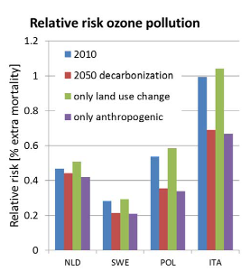Impact of EU energy policy on ground level ozone pollution
Introduction
Anthropogenic activities and associated air pollutant emissions have caused ambient ozone concentrations to rise to levels harmful to humans and vegetation, especially during summer smog episodes. Ozone production in the atmosphere is driven by emissions of nitrogen oxides (NOx) and volatile organic compounds (VOCs) from natural and anthropogenic sources. EU energy policies aimed at reducing GHG emissions can influence both anthropogenic emissions of air pollutants and biogenic VOC emissions, the latter because of land use change. This study assesses the impact of changing anthropogenic emissions and land use because of EU energy policy on ground-level ozone pollution, also including climate change.
Methods
The impact of two energy scenarios on European ozone levels was calculated. Anthropogenic emissions were taken from the Greenhouse Gas and Air Pollution Interactions and Synergies (GAINS) model and land use change from the Global Biosphere Management Model (GLOBIOM), which both used energy scenarios developed by PRIMES: a current legislation (CLE) case and a decarbonization scenario with 40% reduction of GHGs plus extra energy efficiency measures. Using these datasets, ozone levels and damage indicators for the two scenarios were calculated with LOTOS-EUROS for 2030 and 2050.
Results and conclusions

Land use change causes an increase in isoprene emissions for the EU28 of 20-51% for 2030-2050 compared to 2010 depending on the scenario. Anthropogenic emissions of NOx and VOC are projected to strongly decrease for both the CLE and decarbonization scenario leading to an increase of 3-4% in ozone concentrations for high- NOx regions such as the Benelux but a decrease of 2%-8% over the rest of the domain in 2050. Ozone induced relative risk (RR) of death decreases across Europe from 0.3 – 1.3% in 2010 to 0.22 – 1.0% for 2050 (see figure). The change in anthropogenic emissions is the dominant driver for the observed change in ozone health damage. We found that climate change could increase relative risk for ozone by a factor 1.09-1.78 compared to current climate conditions, which means that climate change will, depending on region in Europe, partly or completely cancel out the reduction achieved by lower emissions or even increase ozone health damage compared to 2010.
Supervisors
Wolfgang Schöpp, Mitigation of Air Pollution and Greenhouse Gases Program, IIASA Nicklas Forsell, Ecosystem Services and Management Program, IIASA
Note
Carlijn Hendriks, of the Netherlands Organisation for Applied Scientific Research (TNO), is a citizen of the Netherlands. She was funded by the IIASA Dutch National Member Organization and worked in the Mitigation of Air Pollution and Greenhouse Gases Program during the YSSP.
Please note these Proceedings have received limited or no review from supervisors and IIASA program directors, and the views and results expressed therein do not necessarily represent IIASA, its National Member Organizations, or other organizations supporting the work.
Further information


